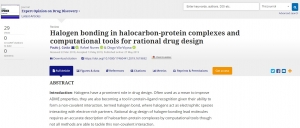
Paulo J. Costa, Rafael Nunes & Diogo Vila-Viçosa (2019) Halogen bonding in halocarbon-protein complexes and computational tools for rational drug design,Expert Opinion on Drug Discovery
Introduction: Halogens have a prominent role in drug design. Often used as a mean to improve ADME properties, they are also becoming a tool in protein–ligand recognition given their ability to form a non-covalent interaction, termed halogen bond, where halogens act as electrophilic species interacting with electron-rich partners. Rational drug design of halogen-bonding lead molecules requires an accurate description of halocarbon-protein complexes by computational tools though not all methods are able to tackle this non-covalent interaction.
Areas covered: The authors present a review of computational methodologies that can be used to properly describe halogen bonds in the context of protein–ligand complexes, providing also insights on how these methods can be used in the context of computer-aided drug design.
KEYWORDS: Halogen bonding, protein-ligand complexes, drug design, σ-hole, force field, molecular docking, quantum-mechanical calculations.



